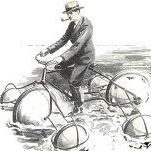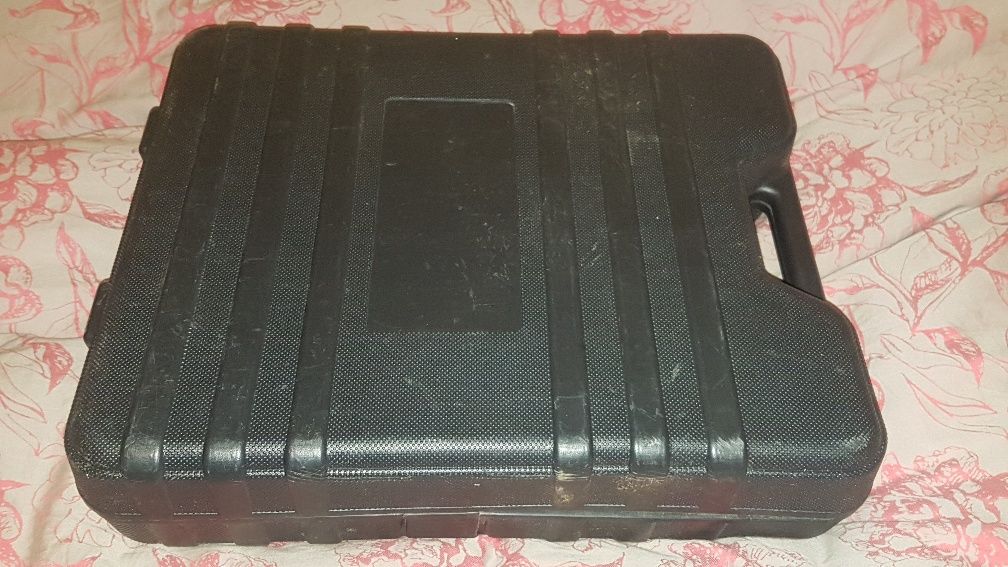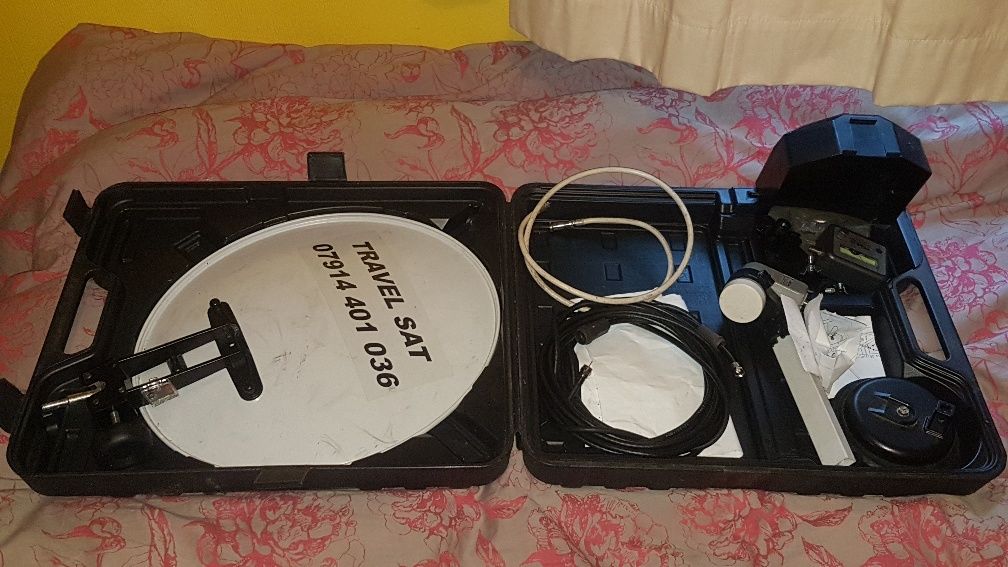Leaderboard
Popular Content
Showing content with the highest reputation on 17/09/20 in all areas
-
Hi all My first post on this forum. I don't have a canal boat but enjoy walking along canals and sometimes chatting to boaters / helping them lock. On Monday night 14/9 I found a satellite dish in its case (open) on the towpath and want to try to reunite it with its owner. It's from Travel Sat and I called Martin the owner of this business via the mobile no shown, thinking he might be able to look up the person he sold it to via the serial no BUT these dishes don't have them and he's sold about 1000! Martin was very helpful in talking me through checking and assembling this thing via WhatsApp video and we have ascertained that it's all present and correct apart from a missing screw (1 of 4) on the mounting bracket and a minor broken lug on the bracket - neither of which stop it from working, just need to be more gentle when tightening the knurled wheel acc to Martin. If you think this might be yours, contact me to tell me where you lost it. There are also some accessories in the box with it which acc to Martin aren't standard but are extra. What are these? Mark5 points
-
This post cannot be displayed because it is in a forum which requires at least 10 posts to view.
-
In all fairness, that looks like my forward course.4 points
-
Nah, if that was the case when you got a line of boats together they would just disappear! ??4 points
-
This post cannot be displayed because it is in a forum which requires at least 10 posts to view.
-
3 points
-
This post cannot be displayed because it is in a forum which requires at least 10 posts to view.
-
On a budget is not the same as dishonest. The people who take these things are just thieving scumbags , its not like stealing food because they are starving to death.3 points
-
This post cannot be displayed because it is in a forum which requires at least 10 posts to view.
-
This post cannot be displayed because it is in a forum which requires at least 10 posts to view.
-
This post cannot be displayed because it is in a forum which requires at least 10 posts to view.
-
2 points
-
remember if you pass a boat whilst reversing that strongly smells of Wizards Cabbage, don't forget to speak and shout greetings backwards too, that'll really freak 'em out2 points
-
The higher end of the market maybe, but the type stolen in urban areas from boats usually end up on the canal bed a few yards away, especially if like Lady G's they can't even be ridden. I get pestered by scum trying to sell stolen bikes where I work in Sheffield, sometimes for as little as £10. I'll often see the bike left leaning on a wall somewhere nearby when they've got bored of wheeling it around with the sales pitch "do you want a mountain bike pal? It's 500 quids worth but you can have it for 20" One of the regular shits turned up with a set of triple aluminium ladders once which I could have for £25. There was probably some poor bugger stuck on a roof up the road!2 points
-
This post cannot be displayed because it is in a forum which requires at least 10 posts to view.
-
The description of what happens during charge and discharge is pretty much on all fours with the description in a 1940's specialist textbook on accumulator charging. At thst time it was common practuce to recharge accummulators from DC mains via a lamp board, the number and wattage of the lamps determining the charging current. Charging would continue untill all cells in a battery were gassing freely, meaning that all cells were able to attain a fully charged state in which even the sulphate in the deepest layers of active material would get converted. It was considered safe to discharge down to 1.8V per cell: deeper discharge would result in the production of hard crystalline sulphate having a different crystal structure to the sulphate produced at higher discharge voltages, and it is the hard sulphate that is virtually impossible to convert back. The voltage drop at high current discharges is due to the sulphuric acid reacting with the plates by giving up its sulphur; the reaction generates water which dilutes the acid near the plates and hence affects the chemical reaction that generates the current. Allowing the battery to rest allows fresh concentrated acid to diffuse into the active material, thereby raising the voltage again. I don't think that sort of constant current charging is practiced much these days. Charging until the voltage reaches a value indicative of full charge is fine if all cells are balanced. However, the voltage of a weak cell can rise to a higher level than the other cells, thereby tricking the control circuitry into terminating the charge cycle before the other cells are fully charged. Installing a solar charger is a good move. In a recent post of another thread the poster reported that his boat was fitted with solar panels last year, and that after several months of non-use, his batteries, which his instruments had indicated had lost a significant amount of their original capacity before the perid of non-use, were now being indicated as in good condition. Possibly the enforced period of resting had allowed the conversion of the deeper regions of the active material to be regenerated as there would have been plenty of time for the electrolyte to diffuse into the deepest sulphate layers, allowing them to become converted. Trickle charging at a low current is known to be a good way of keeping a battery in good order, but is not practical in a canal boat whose battery is used every day. Rapid charging of really heavily discharged batteries is not recommended for ordinary batteries: the resulting high current density in the conductive regions of the plates between the higher resistance sulphated regions will give rise to differential thermal expansion between sulphated and non-sulphated regions, resulting in shedding of active plate material and loss of capacity. Trickle charging keeps the current density and temperature rise low, reducing the likelihood of shedding active material.2 points
-
2 points
-
2 points
-
This post cannot be displayed because it is in a forum which requires at least 10 posts to view.
-
This post cannot be displayed because it is in a forum which requires at least 10 posts to view.
-
2 points
-
I tried to get rid of an old bike, left it on the roof for ages, went around the network etc.. Nope not got nicked, so I left it on the towpath for anyone to keep. Four days later someone returned the bike to me thinking I had lost it. Next time I will padlock it, with a chain, someone is bound to nick it then.2 points
-
2 points
-
Looks like there's two dents in the stern, one each side - could those be from where it contacted the weir structure either side of the gate it got towed off? Would imagine it would have hit with quite a bit of force, plus force of water pushing it inwards could easily have made those dents I'd have thought?1 point
-
However skilled or experienced your surveyor is please don't rely on them to pick up on everything - check your boat as carefully as you can before handing over your hard earned.1 point
-
I was in the shower moored on the Thames when someone nicked the bike off the roof about 4 pm. He dropped it when he realised not only was there no seat but the handlebars were 90 deg to the front wheel.1 point
-
I agree with all but one thing. Although a surveyor can't say anything definitive about battery sulphation or even cell shorts if he knew his stuff he should be able to spot and report on indications of such faults (battery design allowing). Bowing case ends or lifting cell tops indicate a serious degree of sulphation while individual dry cells are fairly indicative of that cell gassing excessively so may well have internal shorts. having said that I bet few bother to look, mine certainly did not so its down to the potential owner if getting new may be an issue.1 point
-
I just don't think he's clever enough for the programmes they give him, so key points of the discussion go over his head and he isn't capable of guiding the conversation. His brother is probably the sharper of the pair.1 point
-
Pretty sure bunch isn’t the correct collective noun to describe fascists; though to be fair the most app one probably isn’t allowed in polite society1 point
-
Since I refuse to listen to his programme, because he loves to sensationalise everything, what was this all about?1 point
-
Ta. Bit of filler and a lick of paint it will be better than new then. Preferable to a fire salvage though.1 point
-
Thanks Derek. Much appreciated. Very kind of you to take the time to do this.1 point
-
This post cannot be displayed because it is in a forum which requires at least 10 posts to view.
-
In the shadow world of Government contracts that I inhabit sometimes the definitions are spelled out in plain language: - SHOULD NOT This phrase, or the phrase "NOT RECOMMENDED" mean that there may exist valid reasons in particular circumstances when the particular behavior is acceptable or even useful, but the full implications should be understood and the case carefully weighed before implementing any behavior described with this label MUST This word, or the terms "REQUIRED" or "SHALL", mean that the definition is an absolute requirement of the specification. Means that a rider of an 8MPH scooter should think long and hard and consider the consequences of joining a dual carriageway and if they do must have an orange flashing light displayed. I'd think very hard about being on a road with no escape until the next junction and a speed differential of 62 MPH (worst case) with or without an orange flashing light...1 point
-
It confuses the volockies at Fradley when I reverse down junction lock. Last time the lady off the boat coming up looked very confused and asked if we were going down or up.1 point
-
Also, a useful thing is for crew to be armed with a fender on a piece of string. They can drop it down the side to deflect any potential collision.1 point
-
Looks like they have covered the problem of it turning up in the same place and going adrift again. "Any potential purchaser should have means and proof of being able to remove this boat to a suitable refurbishment centre within 2 weeks of the sale ending. Failure to provide such proof at the time of the close of the sale will result in the cancelation of the sale, loss of deposit & the craft will be instantly offered to the under bidder, Direct from Environment Agency, On Site " What a sensible clause to put in. Environment Agency playing hard ball for a change... About time.1 point
-
This post cannot be displayed because it is in a forum which requires at least 10 posts to view.
-
I would think dragging a chain off the bow, would help keep the bow under control.1 point
-
Some gearboxes don't like long periods in reverse. Others don't care. Check what you have. Also a risk of loosening the prop and even losing it entirely if the nut that holds it on isn't adequately staked. I once had to reverse 6 miles out of the Kyme Eau navigation when I found the winding hole at the current end of navigation was silted up. Took all day. Boats seem to vary in their ability to track in reverse. Some are better than others. Jen1 point
-
just to remind folks that you can buy sanding machines that look like angle grinders but rotate at 3,000 rpm. these are available in 9" and 5" versions. much safer and can be used for polishing and buffing if needed.1 point
-
1 point
-
It doesn’t actually matter that much what the D.C. voltage is. You can get 12V adaptors that supply all sorts of voltages.1 point
-
Of course, I knew I had seen it somewhere, kindergarten teacher was a Geomorphologist specialising in Solifunction forms of non permeable embankments. Fancy not remembering that! We discussed it regularly over our milk and biscuits. Fatuous.1 point
-
I think this is a bad idea......for all of the reasons above and especially the horrid switching arrangement that would be needed which could fund another battery to make it 5 in the bank! I'd like to throw in 2 other inputs. First, why are you thinking of this idea? If it is that you are not charging your batteries properly now, then how is this going to make it better? One battery might get charged properly once per month (but maybe not Nov – Feb!) but the other 3 will have 3 weeks where you are not taking them to full – because your 'ace' plan of charging one every month is good. 3 weeks is too long time without full charge and sulphation will take place. See below. You will get lulled into a false sense of security - I dont have to worry about my batteries not getting to 100% as they will be fully charged by solar in 3 weeks time! Secondly, there is a technical input. Now, I am not a battery expert, but I am a trained chemist and see a big problem. This isnt something I have seen written about, but as a chemist I understand chemical reactions and what makes them happen and battery chemistry is no different. I would happily debate the following with anyone. A typical lead acid battery is designed with it's plates having a very large surface area. The surface area is increased by having 'pores' in the plates. The production of electrons from the plates is a surface reaction and needs chemical species to travel to that 'site' on the surface or deep in the pores to complete that reaction. On discharge from full, the first electrons appear as a surface charge. It is very easy for each 'site' on the 'easy to get at' surface to give up its electron in the chemical reaction. Once the surface charge is gone then the next 10% of charge out of the battery comes from sites very near the tops of the pores. Lets call them the 90% sites. When the next 10% charge comes out (so the SoC is dropping from 90% to 80%), it is more difficult for the chemical reaction to happen as the reaction is likely in the pores themselves and some of the energy released is needed to provide the activation energy to make the electron releasing reaction take place. (Is this why the voltage drops with SoC????). Anywho, this goes on down until we get to say 50% SoC. By this time, the chemical reaction is taking place half way down the pores so steric hinderance is a key issue and the reaction is much slower needing a bigger activation energy for the 50% sites. Ok that is discharge. We now charge back up. Which sites get converted back first? The 99% or 100% sites on the surface or the 50% sites deep down the pores? From a chemical point of view it is certain it is the 100% sites as they are not sterically hindered and need the least activation energy to turn the lead sulphate back to lead. Once they are full, the charge then does the 90% sites, then the 80% sites and so on. The last sites to be converted as the SoC approaches 100% are the 50% sites deep in the pores and this is why everyone says you must charge with 14.4V. You need the high voltage to provide the high activation energy. Charging the easy to get at sites which give up their electrons easily when discharging from full, charge back up easily with just over 13 Volts unlike the sites deep in the pores. How does this affect my charging then? Well in the OPs case of discharging 3 batteries and only getting up to 100% charge on one offline battery every 4 week, then discharging to 50% and only say getting back to 95% means that the 5% deficit of sites deep in the pores are not going to see a charge until their turn for the 4 week solar boost and will certainly form a hard sulphate deposit that will be very very difficult to remove. Is solar really going to hack it and get the high volatage in to convert that sulphate? Me?, I'd sooner invest in the 4th battery to make my bank bigger so instead of discharging to 50%, I would only be discharging to 63% (ish) and maybe spend all the money you are using on switches to get 5 batteries so discharging to only 70%. All the battery companies show the number of cycles to death increasing for less discharge but these figures usually do not take into account sulphation. The need for higher activation energies for the sterically hindered sites deep in the pores though means that they must be more difficult to react so sulphation will be a key input. Put the biggest bank in you can for longest life. You've got more chance of avoiding sulphation by not discharging as deeply therefore needing less energy to recharge that last 1% of capacity deep in the pores. Problem is, have you got room for 5 batteries? Who's got the popcorn?1 point
-
Matty a fair reminder that it's a tricky market out there for all concerned. Apologies for putting all brokers in the same hat - there are undoubtedly good ones out there, doing a decent job.1 point
-
Henley on Thames a few years ago, some Pillocks nicked a broom of the roof, heard 'em do it too, some posh kids by the sound of the accents, One was called 'Gove' 'cos the other one was braying like a donkey chortling 'well done Govey' and 'Govey' replied 'Jolly good jape eh Boris,, Wonder what happened to the theiving little gits.1 point
-
All wrong so far. It's actually to stop numpties with wide beams escaping out of the marina when moored in stupid locations like the North Oxford etc.1 point
-
This post cannot be displayed because it is in a forum which requires at least 10 posts to view.
-
This post cannot be displayed because it is in a forum which requires at least 10 posts to view.
This leaderboard is set to London/GMT+01:00































